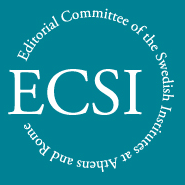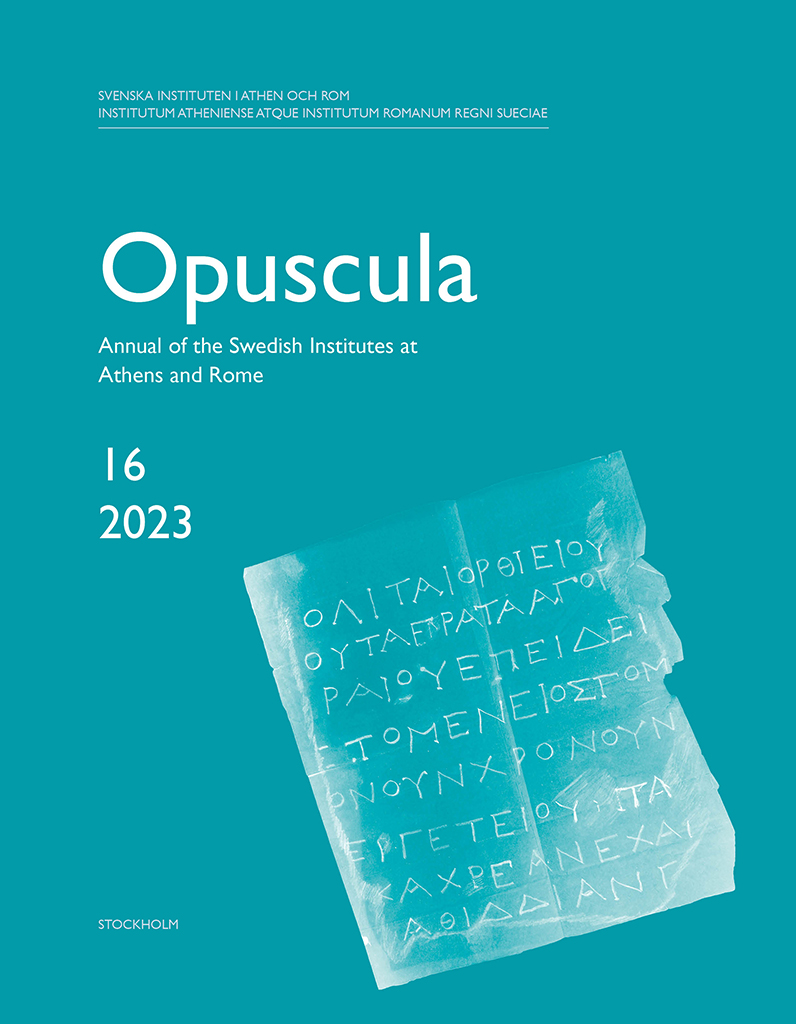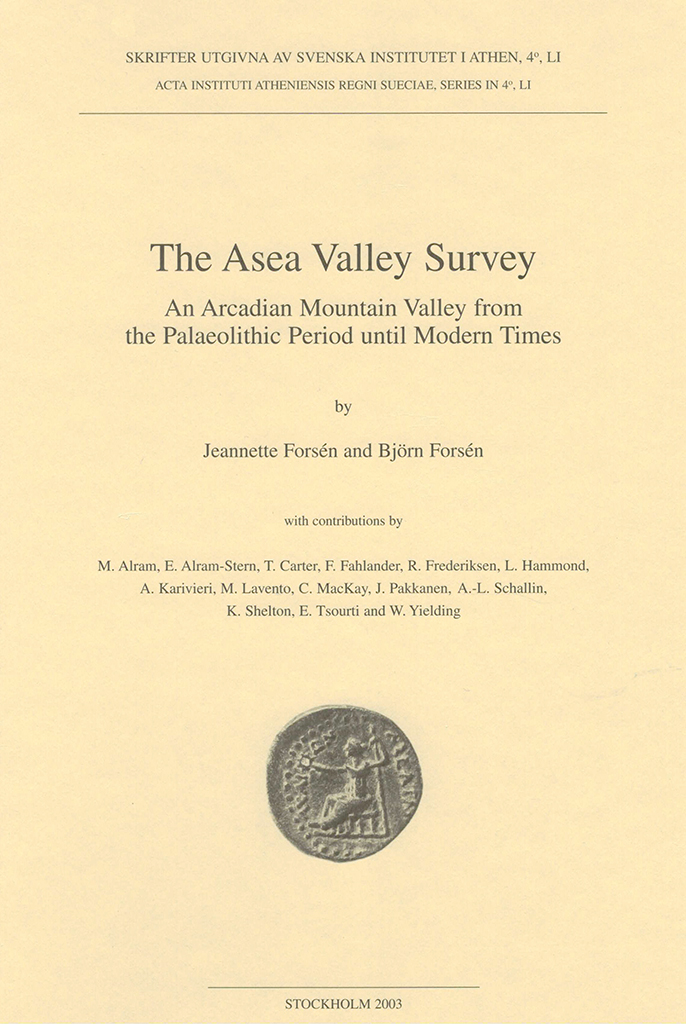Opuscula is published by the Swedish Institutes at Athens and Rome, with the aid of a grant from the Swedish Research Council. Distributed by Eddy.se AB. View journal at ERIH PLUS. All content available with open access. An overlooked 2nd-century BC decree by the polis of the Orthieians, Thessaly By Robin Rönnlund Abstract The National Archive of Monuments in Athens contains a dossier with documents regarding complications relating to road construction works in 1905 at the then-unknown archaeological site of Kedros in Western Thessaly. Among the documents is a paper copy of a fragmentary inscription of the 2nd century BC, reportedly found at the site. The preserved text of the inscription indicates that it was an honorific decree set up by the polis of the Orthieians to a benefactor from the nearby city of Gomphoi. Bibliographical information Robin Rönnlund, ‘An overlooked 2nd-century BC decree by the polis of the Orthieians, Thessaly’, Opuscula. Annual of the Swedish Institutes at Athens and Rome (OpAthRom) 16, Stockholm 2023, 113-131. ISSN: 2000-0898. ISBN: 978-91-977799-5-1. Softcover, 268 pages. https://doi.org/10.30549/opathrom-16-05
Opuscula is published by the Swedish Institutes at Athens and Rome, with the aid of a grant from the Swedish Research Council. Distributed by Eddy.se AB. View journal at ERIH PLUS. All content available with open access. The topography of Hermione—A preliminary outline By Henrik Gerding (Lund University, Sweden) Abstract The preliminary results of a survey of ancient Hermione (epichoric Hermion) are presented in this paper. The survey was conducted during three short campaigns over the period 2015–2017, and focused on the urban layout and development of the ancient city. Because the ancient city area more or less coincides with modern Ermioni, the investigation was mainly restricted to the documentation and analysis of architectural remains that were both still visible above ground and accessible. However, the report also includes a thorough re-evaluation of previous scholarship, taking into consideration remains that are no longer visible. The author identifies three questions of particular interest, relating to the exact location, extent, and potential relocation of the ancient city, and points to the lack of a coherent interpretation. On the basis of present data, the author proposes that Hermione was indeed relocated to a new site, less than 1 km away from its original…
Opuscula is published by the Swedish Institutes at Athens and Rome, with the aid of a grant from the Swedish Research Council. Distributed by Eddy.se AB. View journal at ERIH PLUS. All content available with open access. The 2016–2018 Greek-Swedish archaeological project at Thessalian Vlochos, Greece By Maria Vaïopoulou (Ephorate of Antiquities of Karditsa, Greece), Helene Whittaker (University of Gothenburg, Sweden), Robin Rönnlund (University of Gothenburg, Sweden), Fotini Tsiouka (Ephorate of Antiquities of Karditsa, Greece), Johan Klange (Arkeologikonsult Ltd., Sweden), Derek Pitman (Bournemouth University, United Kingdom), Rich Potter (University of Gothenburg, Sweden), Lawrence Shaw (University of Winchester, United Kingdom), Josephine Hagan (Bournemouth University, United Kingdom), Ellen Siljedahl (University of Gothenburg, Sweden), Matilda Forssén (University of Gothenburg, Sweden), Sujatha Chandrasekaran (University of Gothenburg, Sweden), Sotiria Dandou (Swedish Institute at Athens, Greece), Veronica Forsblom Ljungdahl (National Museums of History, Sweden), Asta Pavilionytė (Bournemouth University, United Kingdom), Hayden Scott-Pratt (Bournemouth University, United Kingdom), Elisabet Schager (National Museums of History, Sweden) & Harry Manley (Bournemouth University, United Kingdom) Abstract The Vlochos Archaeological Project (2016–2018) was a Greek-Swedish archaeological investigation of the remains of the ancient urban site at Vlochos in western Thessaly, Greece. Employing a wide array of non-invasive methods, the project succeeded in…
Published by the Swedish Institute at Athens. Distributed by Astrom Editions. The Asea Valley Survey. An Arcadian mountain valley from the Paleolithic period until modern times By Jeannette Forsén & Björn Forsén, with contributions by Michael Alram, Eva Alram-Stern, Tristan Carter, Fredrik Fahlander, Rune Frederiksen, Leslie Hammond, Arja Karivieri, Mika Lavento, Camilla MacKay, Jari Pakkanen, Ann-Louise Schallin, Kim S. Shelton, Eos Tsourti & Wendy Yielding Abstract This volume presents the finds of the Asea Valley Survey (AVS) carried out 1994–1996 in a mountain valley of Arcadia with the acropolis of Asea, the Palaeokastro, as its focal point. During these three seasons of archaeological surface survey 18.7 km2 of the valley were searched intensively in foot. Artefacts spanning from the Middle Palaeolithic period to the early 19th century were systematically collected and documented. Concurrently a geological team gathered data concerning the ever-changing landscape of the valley. By combining new archaeological and geological data with ancient, Byzantine, Ottoman and Venetian written sources the diachronic history of the Asea valley was reconstructed. Through the discovery of a Middle–Upper Palaeolithic site the regional history has been pushed back to about 50,000 BP. Furthermore, a handful of Early–Middle Neolithic lakeside sites, which produced nothing but…




